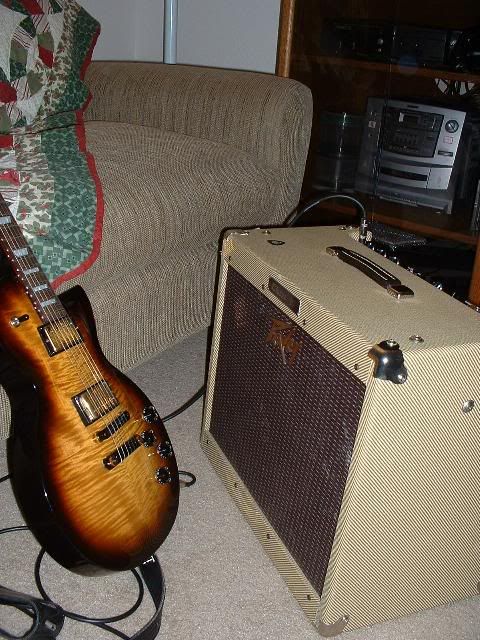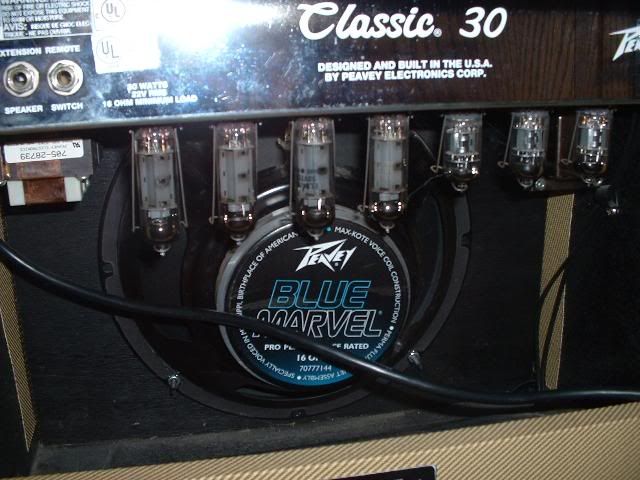I have a cool guitar (LP) and when I play gigs I usually get to play on a sweet Marshall half-stack owned by a good friend of mine, but practice-wise I'm usually stuck with this utter POS bass amp that I got for free about 4 years ago. It's a shiatty little Johnson with a single 8" speaker... man it's crap. But no more!
So I stopped into GC after a lesson and saw my beauty just waiting for me: It's a Peavey Classic 30, Used (read: mad discount, no problems) with the tweed covering (which I prefer to the black).
I tried a blues jr. and a few other non-notables for comparison, and the Classic 30 compared favorably to all. I really did like the blues jr, and it was very similar in sound, but price wise they were not comparable: Picked it up for $300 even.
I guess what impresses me most about it is the truly "tubey" sound, the Marshall I play is tube, but it isn't nearly this "round" sounding. I cranked it pretty hard before I took it, and Wow, does it sing.
Anyways, here some pics for ya, all ya pic mongers!
I can see why people love these things...
Whee!
Do something you love and you'll never work a day in your life...
8)
Well we all shine on--like the moon and the stars and the sun.
-- John Lennon
Nice amp undercat.
The Peavey Classic 30 is one of the most popular amps ever. You can easily gig with this. If you think it sounds good now, wait till you get a chance to crank it a little. You are gonna love that.
Congratulations! 8)
If you know something better than Rock and Roll, I'd like to hear it - Jerry Lee Lewis
Looks good -- just like a mini version of my tweed Classic 50 4x10. The Classics are definitely good stuff. Enjoy.
BTW, I noticed you front-load your LP tailpiece. Any particular reason?
-=tension & release=-
Undercat,
Looks nice, enjoy...really like that guitar
Chris
"It's all about stickin it to the man!"
It's a long way to the top if you want to rock n roll!
Greg
Wow, you are observant. Sherlock Holmes!
If you know something better than Rock and Roll, I'd like to hear it - Jerry Lee Lewis
Nice amp! Congrats on getting it!
Gun control is using both hands!!!
Looks good -- just like a mini version of my tweed Classic 50 4x10. The Classics are definitely good stuff. Enjoy.
BTW, I noticed you front-load your LP tailpiece. Any particular reason?
Nice catch, a lot of folks don't notice it until they actually PLAY the guitar.
A reason? Actually yeah. For long time I was convinced that what happened after the tailpiece couldn't affect my guitar in a meaningful way, but after reading some discussions on it on the LP forum and having some casual chats with a couple of the tech's in my area, I was convinced that changing the angle of the strings as they come off the tailpiece and go to the bridge, the feel of the guitar could be altered.
My first go at it was raising the tailpiece way up, but I hated the way it looked and felt underneath my hand. So a while later I was perusing the same forum and came across some thread about Zakk Wylde (who is currently the most famous purveyor of this method) and decided to give it a try.
Presto: the feel is there, the tailpiece is low, and it's another one of the things that makes the guitar look somewhat unique.
Incidentally, lessening that angle tends to give the strings a looser feel, make bending seem easier, and bring out lower harmonics in an extremely subtle way. Some folks say it's feels like it's getting sloppy, but that just compliments my playing style! :lol:
There are a reasonable number of people who choose to do it that way because they feel that it's how the tailpiece was "meant" to be used, because that's how it was wrapped before the whole tune-o-matic system was put together ('56 if I remember correctly), but my reasons are purely for it's playing features, rather than it's sentimental value.
Here's an example of what I mean.
I would give credit to the owner both for the ownership and for a great picture, but they went to annoying lengths to keep me from getting this... so I shall spite them! http://www.lespaulforum.com for more pics of sweet old LP's. See the "Guitar Registry" for some great specimens.
Do something you love and you'll never work a day in your life...
Hey Greg: What kind of drivers is your C50 sporting? How would you compare the sound to a 4x10 Hot Rod DeVille?
Edit:
Also, can anyone date these, or does anyone know of a resource for dating by serial or features?
Do something you love and you'll never work a day in your life...
Go to the Peavey Home. On the left you will see Learn and underneath Forums. Sign up and go to amplifiers. I am sure someone will be able to help you date your new amp.
If you know something better than Rock and Roll, I'd like to hear it - Jerry Lee Lewis
Thats cool with the front loading, I might try that sometime.
-Dustin
I've been imitated so well I've heard people copy my mistakes.
- Jimi Hendrix
Hey Greg: What kind of drivers is your C50 sporting? How would you compare the sound to a 4x10 Hot Rod DeVille?
Edit:
Also, can anyone date these, or does anyone know of a resource for dating by serial or features?
Blue Marvels. I bought the Classic 50 because it sounded tighter than a nearby DeVille, which seemed to produce a lot of "barking" in bass transients. I wish I'd tried the Classic 30, as I definitely would have snagged that instead of the 50, which really loud and really heavy.
WRT to the LP tailpiece: I knew of the original wraparound design -- planning on using it for a lap steel I'm currently building. It's interesting you mentioned the looser feel. That's exactly what I was wondering about. The wrap around not only changes the break angle, but increases the length of string from the saddle to the final anchor point. That should make the string feel a bit softer as well.
-=tension & release=-
The wrap around not only changes the break angle, but increases the length of string from the saddle to the final anchor point. That should make the string feel a bit softer as well.
Hmm, hadn't thought about the length, only the breaking angle and the resulting change in tension. Why does the length change anything?
Metaellihead: Thanks for the compliment on the flame. As it turns out, the guitar is not only pretty, but tonally respectable too. I'm going to do some recording with it as soon as I can. I have some already, but the C30 really brings out a lot of it's tonal nuances, and I'm hoping that will show up better on recordings than what I have been using in the past.
Do something you love and you'll never work a day in your life...
Hmm, hadn't thought about the length, only the breaking angle and the resulting change in tension. Why does the length change anything?
It's a phenomenon described by a spring force & displacement equation known as Hooke's law: basically it requires less force to stretch a long string X millimeters, than a shorter version of the same string that same X millimeters. So, add a little extra length behind the bridge (or beyond the nut) and a string will become easier to bend and fret This assumes string can slide freely over saddle and nut -- the T-o-M bridge does cause some restrictions here.
The tension that is changing when one raises or lowers the tailpiece is the tension on the bridge (downward toward the body). The axial tension on the string on either side of the bridge would be exactly the same if the string could freely slide over the bridge. The higher downward tension on the bridge is usually credited with causing better acoustic coupling at the bridge and thus better sustain and different tone.
-=tension & release=-






